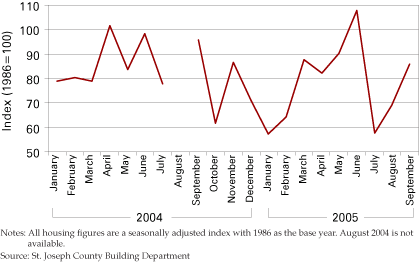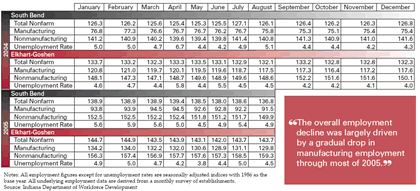South Bend and Elkhart-Goshen
School of Business and Economics, Indiana University, South Bend
The Michiana region’s economy sent mixed signals in 2005, but the outlook for 2006 is encouraging. This analysis examines the major metropolitan areas in the Michiana region, South Bend and Elkhart–Goshen, to provide an overview of the region’s economic conditions and an indication of its future.
Employment
Table 1 reports monthly employment data for the region’s metropolitan areas. From January 2004 to August 2005, total nonfarm employment (measured by a seasonally adjusted index with 1986 as the base year) has decreased slightly. Total employment fell 1.5 percent in South Bend and 0.7 percent in Elkhart-Goshen. Unemployment rates across the region have remained below the national and state averages. The drop in unemployment rates in August 2005 indicates that labor demand has picked up again after a slight decline earlier in the year.
Table 1
Employment Indices with Unemployment Rates, 2005
The overall employment decline was largely driven by a gradual drop in manufacturing employment through most of 2005. Manufacturing employment fell 2.5 percent in South Bend and 3.3 percent in Elkhart–Goshen from January 2005 to August 2005. While the recreational vehicle (RV) industry, which dominates Elkhart County employment, has experienced record growth in the past couple years, it faced declines in the first half of 2005, particularly for luxury motor homes. This was possibly caused by rising interest rates and escalating fuel prices. Rising fuel costs have dampened large-sized SUV sales nationwide, which likely impacted AM General’s local production. The introduction of the smaller-sized H3 Hummer produced outside the metro may reduce sales on the larger, locally produced models.
The second half of 2005 looked more promising for the transportation equipment industry. Demand for towable RVs continued to expand, and the manufactured housing industry rebounded from its slump due to increased demand for temporary housing caused by recent hurricanes. Soon after Hurricane Katrina hit, FEMA initially ordered 125,000 mobile homes and travel trailers, including many from local producers. (1) This increased production will continue well into 2006. In addition, new manufacturing developments in the region will require more workers. For example, Bennington Marine is constructing a new pontoon boat manufacturing plant in Elkhart that will employ 300 to 400 people.
Nonmanufacturing employment has also shown mixed results, falling 1.7 percent in South Bend but expanding 1.9 percent in Elkhart–Goshen from January 2005 to August 2005. This is partly due to a decline in the retail sector in South Bend in terms of the number of establishments and employment from the first quarter of 2004 to the first quarter of 2005. (2) Retail employment, however, should rise in 2006 as new major retail spaces open, particularly in South Bend. Moreover, continued growth in health care and social services contributed to positive expansion in nonmanufacturing. Health care and social services employment grew 5.5 percent from the first quarter of 2004 to the first quarter of 2005 in Elkhart County.
Wages
The average weekly wage rose 2 percent from the first quarter of 2004 to the first quarter of 2005 in St. Joseph County but jumped 4.3 percent in Elkhart County. Manufacturing wages grew 5.2 percent in St. Joseph County and 2 percent in Elkhart. Wages in retail moved slightly, falling 0.3 percent in St. Joseph County and rising 0.7 percent in Elkhart. Wages in the health care and social services industry moved in opposite directions across the region, likely due to differing demand for workers. Wages in this sector fell 1.4 percent in St. Joseph County but increased 6.3 percent in Elkhart County. Given expected regional growth in manufacturing and nonmanufacturing in 2006, average wages will likely continue to rise over the next year—even more so if national expectations of inflation cause upward pressure on wages.
Commercial Real Estate
Occupancy rates rose 4.7 percent from 2003 to 2004. Regional real estate markets have remained strong despite rising interest rates over the past year. (3) Significant commercial development will continue in 2006 with new retail and industrial developments throughout the region.
Housing
Residential construction, measured by a seasonally adjusted index of new single-dwelling housing permits issued in St. Joseph County, remains active (see Figure 1). From January 2004 to September 2005, new housing permits increased 8.2 percent. More dramatic is the substantial growth of 49.2 percent in the first nine months of 2005. It remains to be seen if demand for homes will be dampened by expected interest rate hikes in the near future.
Figure 1
New Housing Index for St. Joseph County

In 2005, the Michiana region has experienced mixed economic signals: fairly flat employment, relatively low but fluctuating unemployment rates, rising wages, increased production in certain sectors, and active real estate markets. The outlook for the coming year is optimistic, with the region expanding production in some manufacturing and nonmanufacturing sectors, growth in retail, higher employment, continued growth in wages, and considerable real estate activity.
Notes
- Linda Lipp, “Indiana’s RV, housing manufacturers prepare to aid Katrina’s victims,” Indiana Economic Digest 5 September 2005.
- www.stats.indiana.edu/cew/.
- CB Richard Ellis, 2004 Real Estate Market Study: Northcentral Indiana and Southwestern Michigan Summer 2005.
Also in this Issue…




